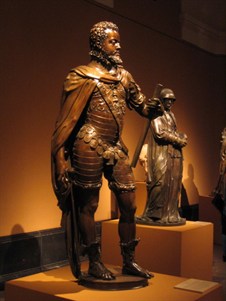Philip II of Habsburg
 Philip II of Habsburg (1527-1598) was King of Spain from 1556 to the date of his death. His father Charles V bequeathed the Spanish dominions, or the crowns of Castile, including the American colonies, and Aragon, including the Italian domains, as well as the Franche-Comté and the Netherlands. He settled in Madrid, and tried to decide the fate of European policy from afar, intervening in many theatres of war. A deeply Catholic sovereign, Philip II contributed enormously, with his expensive foreign policy, to aggravate the state of finances, producing several bankruptcies. Religious and political motivations were at the origin of the rebellion of the Netherlands, destined to extend well over eighty years (1568-1648) and represented one of the major policy failures of the Habsburg ruler. He achieved greater success in quelling the rebellion of the Moriscos (1568-70) and in the historic victory of the fleet commanded by half-brother Don Juan of Austria against the Turks at Lepanto (October 7, 1571). King of Portugal from 1580 as the most direct heir of the deceased king, Philip II failed in his attempt to invade England in 1588, as the ships of the Invencible Armada were scattered because of the bad weather and then beaten by the smaller English fleet.
Philip II of Habsburg (1527-1598) was King of Spain from 1556 to the date of his death. His father Charles V bequeathed the Spanish dominions, or the crowns of Castile, including the American colonies, and Aragon, including the Italian domains, as well as the Franche-Comté and the Netherlands. He settled in Madrid, and tried to decide the fate of European policy from afar, intervening in many theatres of war. A deeply Catholic sovereign, Philip II contributed enormously, with his expensive foreign policy, to aggravate the state of finances, producing several bankruptcies. Religious and political motivations were at the origin of the rebellion of the Netherlands, destined to extend well over eighty years (1568-1648) and represented one of the major policy failures of the Habsburg ruler. He achieved greater success in quelling the rebellion of the Moriscos (1568-70) and in the historic victory of the fleet commanded by half-brother Don Juan of Austria against the Turks at Lepanto (October 7, 1571). King of Portugal from 1580 as the most direct heir of the deceased king, Philip II failed in his attempt to invade England in 1588, as the ships of the Invencible Armada were scattered because of the bad weather and then beaten by the smaller English fleet.
Read more:
- G. Parker, Philip II, Boston-London 1978.
- H. Kamen, Philip of Spain, New Haven 1998.
- P. Williams, Philip II, New York 2001.
